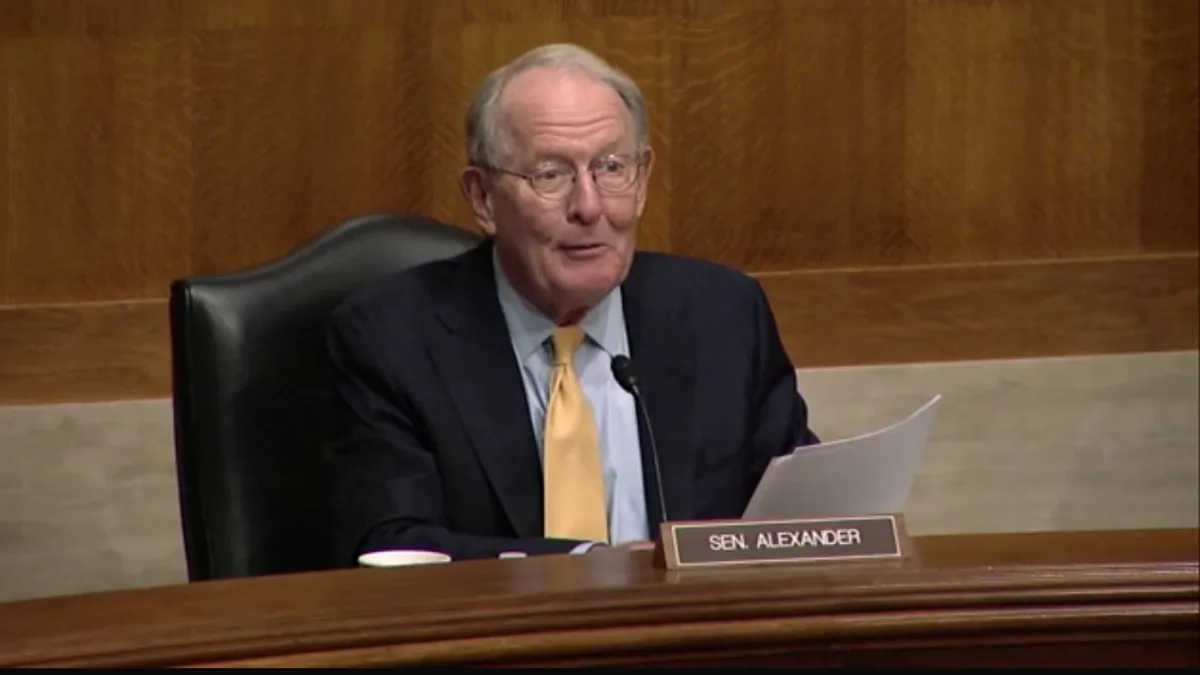Dive Brief:
- Senators on both sides of the aisle on Wednesday signaled their support for permanently removing restrictions to telehealth use at a hearing of the Senate Health, Education, Labor and Pensions Committee. Chairman Lamar Alexander, R-Tenn., said top priorities are axing geographic restrictions and expanding Medicare and Medicaid reimbursement for virtual care services.
- However, lawmakers seemed less interested in retaining payment parity for digitally delivered services, where federal payers reimburse for telehealth visits the same as in-person visits for the same service, and permanently removing HIPAA restrictions that over the course of the pandemic have allowed doctors to treat their patients over a broader array of platforms.
- Testimony from Karen Rheuban, director of the University of Virginia's Center for Telehealth, touted the UVA healthcare system's use of remote patient monitoring for vulnerable and quarantined COVID-19 patients, leveraging devices such as oximeters, blood pressure cuffs, and electronic scales, as well as video capabilities.
Dive Insight:
The Trump administration has widely loosened restrictions to telehealth use amid the pandemic as doctors and patients turned to the service in droves when stay-in-place orders began in March. At UVA Health, for example, the organization expanded its remote monitoring program in response to the crisis, enabling healthcare providers to monitor vital signs 24/7 and make "virtual rounds" for patients at home, Rheuban testified.
Joseph Kvedar, president of the American Telemedicine Association, said at the Senate hearing that remote monitoring technology is particularly valuable for patients with chronic conditions such as congestive heart failure. Remote monitoring is a "fabulous tool" that shares critical patient information with providers in other locations, thanks to "an enriched data stream" that can keep patients out of the hospital and at home.
However, the majority of COVID-19 regulatory changes — including allowing fee-for-service Medicare to cover an unprecedented number of telehealth use cases, not enforcing HIPAA restrictions, allowing doctors to use consumer platforms like FaceTime and Skype for visits and easing licensing requirements — will end abruptly when the national public health emergency ends.
Telehealth vendors, providers and patient advocates have clamored for HHS to retain some, if not all, of the 31 federal policy changes, but the majority necessitate Congress to pass additional legislation. Washington continues to debate which, if any, restrictions to virtual care should be permanently relaxed after the pandemic is over.
But the hearing — and a smattering of recent bill introductions — signals growing congressional support for the digitization of healthcare delivery.
"I suspect we're talking about the biggest change in healthcare delivery in a long time, if not ever," Alexander said. He has called for legislative action on pandemic preparedness, including provisions targeting telehealth, before the end of this year.
Several of his Democratic colleagues on the panel backed the need to keep the momentum for virtual care up, with Sen. Tim Kaine, D-Va., saying he hopes more telehealth provisions make it into the next round of COVID-19 legislation.
UVA's Rheuban and ATA's Kvedar agreed the changes were critical and urged quick action to codify them.
"These restrictions serve no other purpose than restricting access to care," Kvedar said.
Employer group the ERISA Industry Committee (ERIC) and the Connected Health Initiative, an industry backed group, both sent letters to HELP urging Congress to make the relief, especially around geographic restrictions and Medicare coverage, permanent, and work with states and the private sector to expand access.
"We've got this lag that comes back to reimbursement," Sen. Lisa Murkowski, R-Alaska, said.
But Sen. Mike Braun, R-Ind., said he was "disappointed" to see widespread pricing parity across federal and commercial payers, given telehealth's ability to drive cost savings in the pricey healthcare industry. Prior to the pandemic, insurers paid roughly 20% to 50% less for virtual care visits.
Lawmakers were also leery of an HHS decision to not enforce specific HIPAA requirements during the public emergency, airing concerns about the potential for fraud and abuse from hackers and businesses collecting and selling patient information without their knowledge. Vendors could be made to sign a business associate agreement including them under HIPAA's protections.
"The question of whether to extend the HIPAA privacy waivers should be considered carefully," Alexander said.
Experts and those at top levels of Trump's healthcare administration, have said the genie is pretty much out of the bottle as the pandemic drives unprecedented adoption.
The number of Medicare beneficiaries using telehealth grew more than 11,718% in just a month and a half early on in the pandemic.
CMS Administrator Seema Verma said in late May her department is evaluating the telehealth waivers to determine whether any should be extended past the scope of the emergency and is looking at additional rulemaking on the issue.
And, though Cowen analysts said long-term telehealth change will likely appear in the second iteration of the Cures act sometime next year, both Democrat and Republican lawmakers have recently introduced bills chipping away at the restrictions to telehealth.
Those include the HEALTH Act, which would make Medicare payments for telehealth at federally qualified health centers and rural health clinics permanent, and a bill alloting $50 million for a program supporting remote monitoring in rural health and community health centers.
Roughly 30 senators signed a Monday letter to Senate leadership urging the the body to solidify measures that contributed to the expansion in virtual care, including nixing site originating requirements. The letter pulled many of its points from the CONNECT for Health Act, a darling with telehealth advocates introduced last year.
"Congress should expand telehealth on a permanent basis so that it remains an option," the letter reads. Doing so would ensure continuity of care for patients, while proving certainty to providers that implementing virtual care is a "sound long-term investment."













